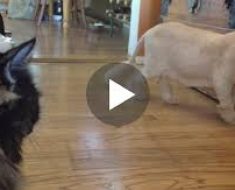Whenever I’m out in nature, I find myself a little overwhelmed by how much spectacular beauty there is on this planet.
If you’re a city dweller like me, you quickly start to appreciate that every flower and blade of grass is a tiny miracle.
Unfortunately, there are lots of folks out in the world who don’t fully appreciate all that natural splendor. There are still far too many people who would rather topple a rare tree for wood than let it live and reproduce.
Fortunately, those folks are balanced out by the many open-hearted citizens of the world who want to protect Mother Earth!
Chief among these hardy souls? The good folks at the U.S. Fish and Wildlife Service. They protect the ecology of our country every day, and this spring is no exception.
Springtime is when many animals reproduce, including fragile and delicate creatures such as hummingbirds.
With that in mind, the USFWA is here to warn everyone about what to do — and what not to do — if they stumble on a hummingbird nesting area.
The U.S. Fish and Wildlife Service recently took to Facebook to issue an important warning about hummingbird nests.
The message quickly made a huge impact on the web, with tons of Facebook users sharing their words with friends and family.
All told, the post garnered more than 250,000 shares from respectful nature buffs trying to help keep hummingbirds safe.
The message went up online with a spectacular photo of a hummingbird nest in the wild.
The image, attributed to a photographer named Kelly Campbell, is a delicate portrait of an almost impossibly tiny bird’s nest caught in the branches of an evergreen.
It’s a fairy tale image for these pixie-like birds, which are typically less than one-tenth of an ounce in weight.
The USFWS also added a few powerful words about what to do if you happen to find one of these nests out in nature.
They write: “Hummingbird eggs are tiny, about the size of jelly beans! Please remember to carefully check for nests before you trim trees and shrubs this spring.”
It’s an important warning for nature-lovers and homeowners alike.
Hummingbirds live all over the Americas. These versatile creatures can be found as far south as Chile and as far north as Alaska during the summer months. They make their homes wherever the conditions are right.
They especially love gardens because they make for comfortable habitats.

A hummingbird will often choose to set up a household in a well-maintained human garden.
If you have bright, nectar-rich flowers, and have hummingbird feeders and birdbaths in your garden, these tiny birds may just move in.
Of course, if hummingbirds decide to start a life in your garden, they may also decide to start a family.

Female hummingbirds build small, delicate nests out of spider webs, moss, and leaves.
They like to build on down-sloping branches over running water when possible, but will build in all sorts of environments.
They then decorate the nests with bits of lichen to help disguise and camouflage the nest.
This is an effective strategy for keeping their eggs safe from predators, though it might increase their risk of garden-maintenance calamity.
So, if you live in the Americas, make sure you’re taking a close look at your garden before you do too much pruning or weed whacking.
You might miss an unruly branch or two, but you could be saving dozens of little lives!
If you love hummingbirds, be sure to SHARE this message to help keep them safe!









